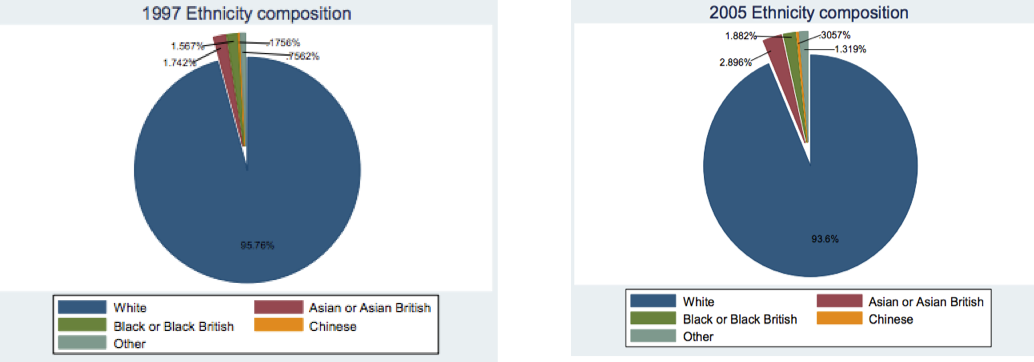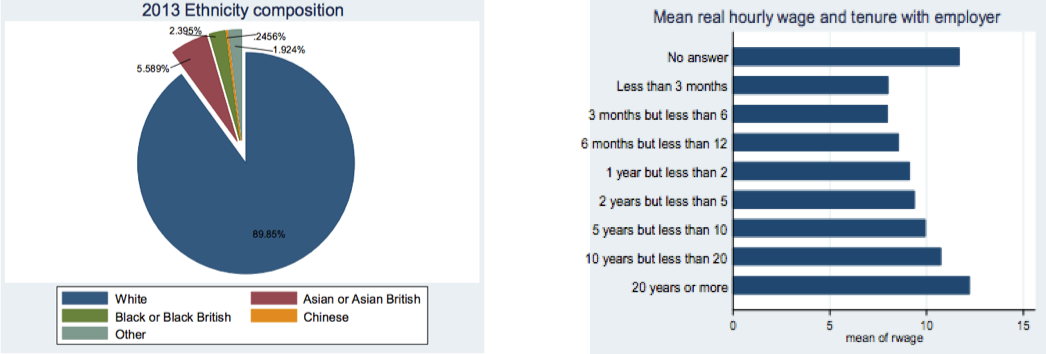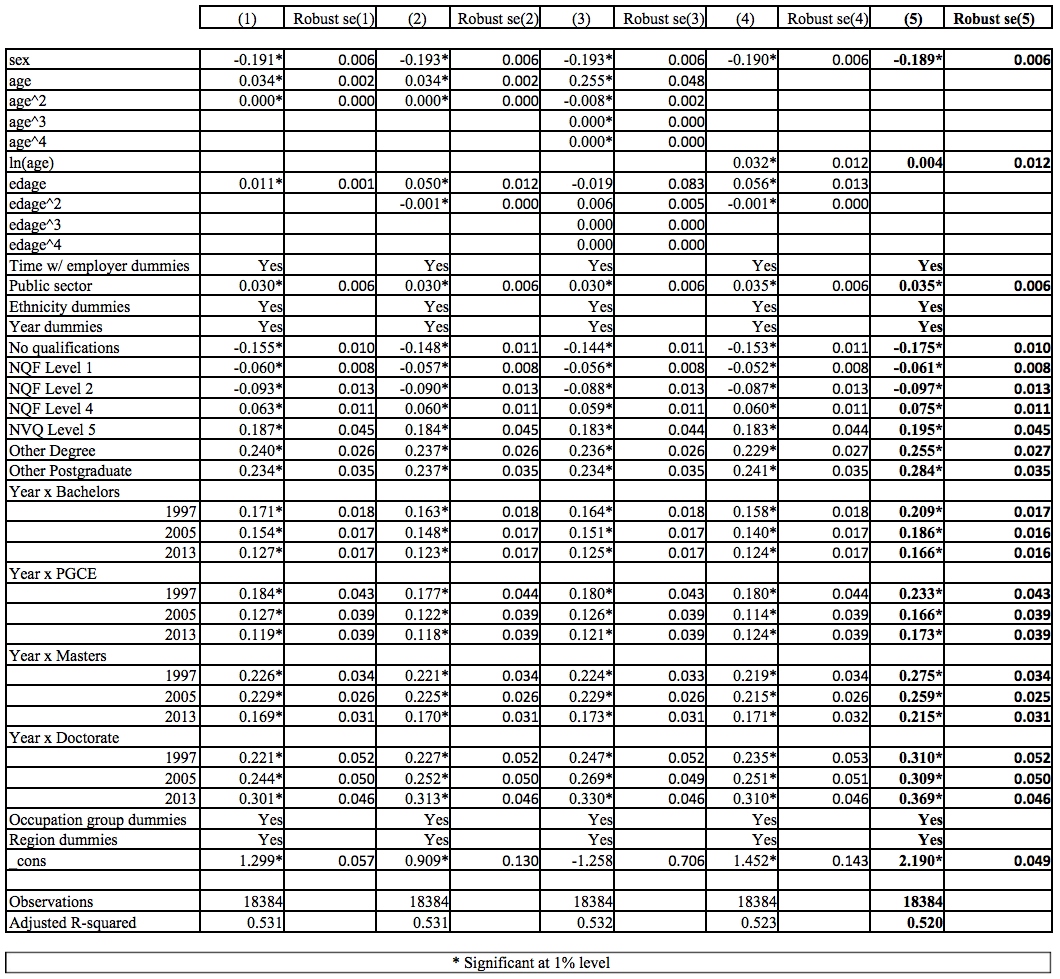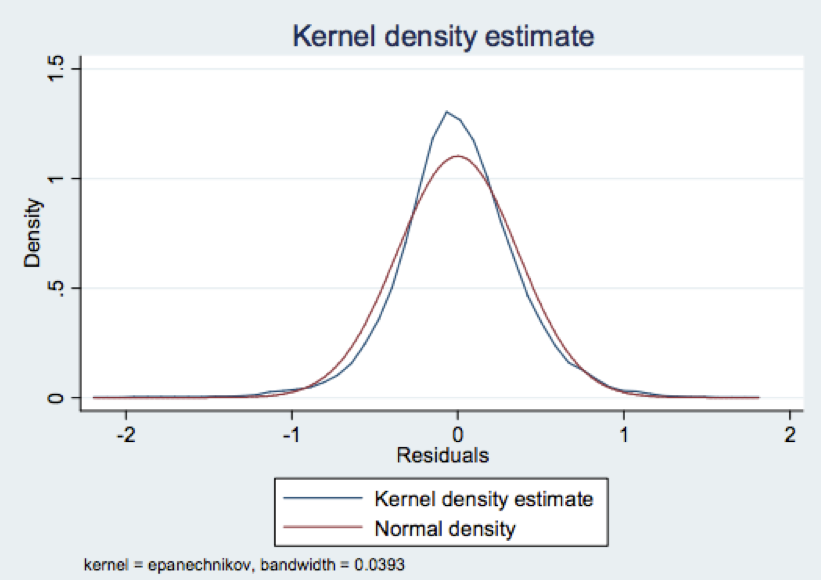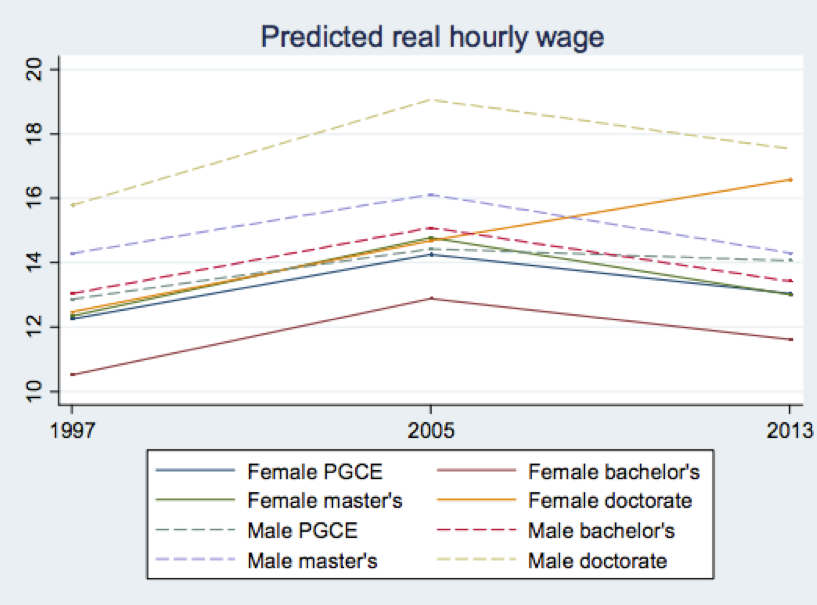The Value of a Graduate Degree: Changing Returns to Postgraduate Qualifications in the UK
By
2014, Vol. 6 No. 09 | pg. 2/2 | « ResultsFirst we compare our findings (Figure 10) to those in the literature by using the model that does not account for the structural break found in the previous section. Only this allows for a real comparison to recent findings as regards changing returns to bachelor’s and master’s degrees. Then we present our more specific findings (Figure 11) with a special focus on the returns to a doctoral degree, broken down by gender, as formalized at the end of the last section. Other things being equal, we find that over the years the returns to a bachelor’s degree (relative to the default of NQF3 / A-level) have fallen: in 1997 the returns were 23.21%; in 2005 20.46% and in 2013 18.06%. This suggests a changed picture from Walker and Zhu (2005) who report that in 2005 there was no evidence that the increase in the number of graduates was leading to falling returns. We also find that the returns to a master’s degree have fallen: 31.60% in 1997, 29.63% in 2005 and 23.93% in 2013. The returns to a PGCE follow a similar pattern. However, we find that the returns to a doctorate have risen sharply in recent years, from slightly over 36% in both 1997 and 2005 to 44.65% in 2013.Allowing for structural change by gender our model provides some additional interesting insights. Irrespective of gender, the returns to a bachelor’s degree have fallen consistently over the three periods: for males the return (again relative to NQF3) was 24.54% in 1997, 19.45% in 2005 and 17.85% in 2013; for females the returns were 23.71% in 1997, 22.29% in 2005 and 19.00% in 2013. Regardless of gender the returns to a master’s degree have also fallen: for men the returns were 30.99% in 1997, 25.93% in 2005 and 21.92% in 2013; for females the returns were 36.36% in 1997, 36.17% in 2005 and 27.48% in 2013. PGCE returns demonstrate a similar decreasing pattern irrespective of gender. In contrast, the return relative to no qualifications for a doctorate has broadly increased over the years, irrespective of gender: for males the returns were 36.41% in 1997, 41.15% in 2005 and 42.31% in 2013; for females 44.81% in 1997, (only) 29.22% in 2005 and 49.46% in 2013. While females enjoy a higher marginal effect of higher education levels, as Figure 13 shows, their overall wages are consistently lower. Indeed Figure 13 shows that the predicted wage is converging for males and females for doctorate holders, corroborating the prediction of Lindley and Machin (2013a) of some gender convergence and providing some evidence of improved social mobility for women. The sample sizes of males and females across the three years permit us varying degrees of confidence in our results. The samples are large (above 300 in all cases) for individuals for whom a bachelor’s is their highest qualification, giving us a high degree of confidence in our findings of decreasing returns. Similarly, our sample sizes for master’s remain relatively large: while the male sample remains at approximately 100, we note with interest that the number of women undertaking master’s study increased from 49 in 1997 to 100 in 2005 and 135 in 2013, providing additional evidence of improved female social mobility. However, the sample size of about 30 individuals of each gender in each year for doctorate students permits us less confidence in our results; though we note that the number of female individuals undertaking doctorate studies has also increased over the three periods. Our findings conform to expectations: with ever more individuals undertaking a first degree, more individuals are choosing to pursue master’s study to distinguish themselves in the workplace and increase earning power with employers. This can partly be seen as a response to demand side pressures and skill-biased technical change (Lindley and Machin, 2011). There has been significant technological growth and more educated workers are likely to be better able to work with the new technologies, particularly IT technology. Indeed, utilizing a Constant Elasticity of Substitution production function, Lindley and Machin (2011) contend that graduates and postgraduates are imperfect substitutes in production with respect to their ability to use new technologies. Yet as more individuals undertake postgraduate study, the resulting increased supply of postgraduates has led to a fall in their real wage – and it appears that perhaps to distinguish themselves in the workforce more individuals are undertaking doctoral studies. The increasing number of individuals undertaking postgraduate education are a source of concern for policy regarding social mobility, as Lindley and Machin (2013a) posit. The recent £9,000 cap on undergraduate fees means that it has become more expensive to acquire a bachelor’s degree; the additional £20,000 per year (Lindley and Machin 2013a, p. 3) for a master’s course and the difficulty of getting funding in most cases may mean that postgraduate study is only possible for students from affluent backgrounds. This raises serious concerns about social mobility and may threaten to extend wage inequality. ConclusionIn contrast to some previous empirical work, we find that the returns to both bachelor’s and master’s degree have fallen over the years, while doctorates continued to drive increasing returns to wage earners. Moreover, we observed that the change in returns for bachelor’s, master’s and doctorates were shared by both genders. The increasing number of individuals undertaking postgraduate study should also stimulate concerns about social mobility (Marr 2012, p.3, Lindley and Machin 2013, p.22). Postgraduate qualifications are expensive, funding is limited, and on the whole postgraduate degrees are more attainable for students from affluent backgrounds. Increasing returns to postgraduate qualifications may mean that only the already wealthy are able to attain such qualifications, perpetuating a cycle of social immobility. Thus as Lindley and Machin (2013a, p. 6) suggest, the government should consider new methods, such as increased funding opportunities, to would prevent the brightest graduates from being priced out of postgraduate education. Taking other European countries as an example, where postgraduate qualification is very cheap and in some cases even for free, the UK needs to consider the implications that follow. Lindley and Machin (2013a, p.22) conclude that Britain is a low mobility nation in terms of social mobility. In a more globalized world, labour mobility is increasing and the easy access to postgraduate education on the Continent and hence their highly qualified labour force might affect the competitiveness of the UK’s own labour force in the long run. ReferencesBlackburn, M.L., & Neumark, D. (1995). ‘Are OLS Estimates of the Return to Schooling Biased Downward? Another Look’. The Review of Economics and Statistics, Vol. 77, No. 2, pp. 217-230. Clarke, K. (2005). ‘The Phantom Menace: Omitted Variable Bias in Econometric Research’, Conflict Management and Peace Science, Vol.22, No.4, pp. 341-352. Griliches, Z., & Mason, W. (1972). ‘Education, Income and Ability’, Journal of Political Economy, Vol.80, No.2, pp. S74-S103. Harmon, C., & Walker, I. (1995). 'Estimates of the Economic Return to Schooling for the United Kingdom', American Economic Review, Vol. 85, No. 5, pp. 1278-1286. Katz, L., & Murphy, K. (1992). ‘Changes in Relative Wages, 1963-1987: Supply and Demand Factors’, Quarterly Journal of Economics, Vol.107, No.1, pp. 35-78. Lindley, J., & Machin, S. (2011). ‘Rising Wage Inequality and Postgraduate Education’. Discussion Paper Series, Forschungsinstitut zur Zukunft und Arbeit, No.5981 Accessible under: http://hdl.handle.net/10419/55120 Lindley, J. and Machin, S. (2012), ‘The Quest for More and More Education: Implications for Social Mobility’. Fiscal Studies, Vol. 33, No.2, pp. 265–286. Lindley, J., & Machin, S. (2013a). ‘The Postgraduate Premium: Revisiting trends in social mobility and educational inequalities in Britain and America’. Accessible under http://www.kent.ac.uk/graduateschool/Postgraduate%20premium%20Sutton%20Trust%20rep ort.pdf Lindley, J., & Machin, S. (2013b). ‘The Rising Postgraduate Wage Premium’. JEL Classifications: J24; J31. Accessible under: http://personal.lse.ac.uk/machin/pdf/jl%20sm%20october%202013.pdf Lipsett, A. (2009). ‘Huge Increase in Demand for Postgraduate Degree Courses’, The Guardian, 17 February. Accessible under: http://www.theguardian.com/education/2009/feb/17/rise-applications-postgraduate-degrees Machin, S., & Van Reenen, J. (2007). ‘Changes in wage inequality’. Centre for Economic Performance special papers, CEPSP18. Centre for Economic Performance, London School of Economics and Political Science, London, UK. Accessible under: http://eprints.lse.ac.uk/4667/ Marr, L. (2012). ‘Social mobility, higher education and lifelong learning’. Widening Participation & Lifelong Learning, Vol. 14, No. 2, pp. 3-10. Mincer, J.A. (1974). ‘The Human Capital Earnings Function’. In: ‘Schooling, Experience, and Earnings’, Columbia University Press, p.83-96. Accessible under: http://www.nber.org/chapters/c1767 Walker, I., & Zhu, Y. (2005). ‘The College Wage Premium, Overeducation, and the Expansion of Higher Education in the UK’. IZA Discussion Paper No.1627. Accessible under: http://ftp.iza.org/dp1627.pdf AppendixFigures 6 & 7 Figures 8 & 9 Figure 10: OLS Results Figure 11 Figure 12 Figure 13
Suggested Reading from Inquiries Journal
Inquiries Journal provides undergraduate and graduate students around the world a platform for the wide dissemination of academic work over a range of core disciplines. Representing the work of students from hundreds of institutions around the globe, Inquiries Journal's large database of academic articles is completely free. Learn more | Blog | Submit Latest in Economics |







